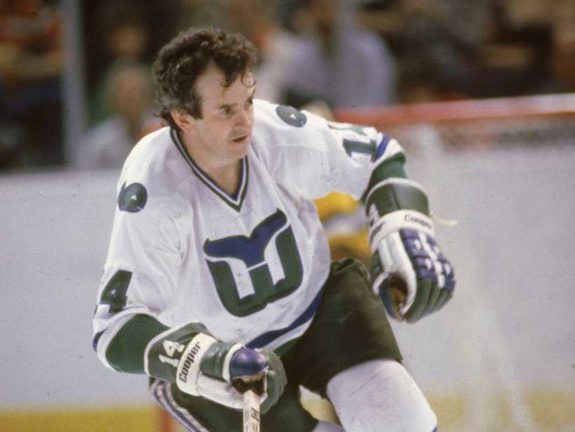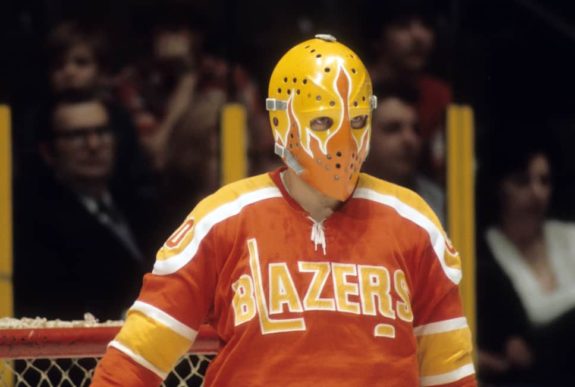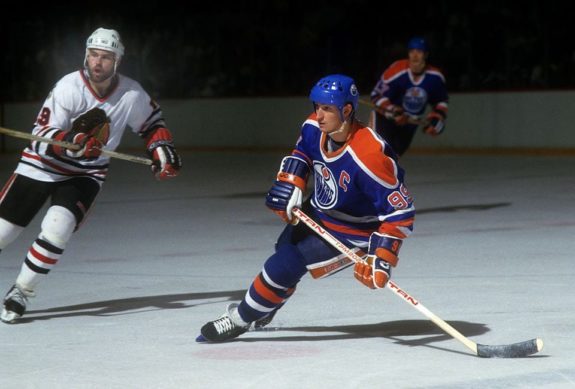
 Ed Miller
The Hockey Writers
Ed Miller
The Hockey Writers
57
Reads
0
Comments
The WHA – A Look Back at the Upstart Hockey League
As the National Hockey League continued to prosper in the early 1970s, there was a demand for more teams in more cities throughout much of the United States and Canada but at such a high risk, the league was hesitant to attempt to grow too quickly. After all, it took almost 41 years to branch out from the “Original Six” format and add six additional teams.
Related: The NHL’s Original Six
With smaller markets craving professional hockey, it was clear that there was a legitimate possibility in creating a rival to the NHL, both in attendance and television ratings and thus the World Hockey Association was created in 1972. The WHA wasn’t the first league that started in an attempt to steal the NHL’s thunder but it remains the most successful to date.
67 NHL Players Jump Over to the WHA
The goal of the WHA was to capitalize on the lack of teams in several major cities but without players who were household names, it seemed evident that the league wouldn’t stand a chance – much like the Western Hockey League and Pacific Coast Hockey Association that came before it. The newly formed league reached deep into its pockets – much to the dismay of the NHL – and signed sixty-seven NHL players, the biggest of whom were Gerry Cheevers, Bernie Parent and Bobby Hull – who earned an unprecedented 10-year, $2.75 million contract with the WHA’s Winnipeg Jets. The following year, the league would bag the biggest name in hockey – Gordie Howe – after the NHL turned its back on “Mr. Hockey”, creating major friction between the two leagues that would never vanish.
The WHA’s First Season
In its embryonic stages, the WHA consisted of 12 teams – the New England Whalers, Cleveland Crusaders, Philadelphia Blazers, Ottawa Nationals, Quebec Nordiques, New York Raiders, Winnipeg Jets, Houston Aeros, Los Angeles Sharks, Minnesota Fighting Saints, Alberta Oilers and Chicago Cougars. Many of the nicknames had cultural significance for their specific areas which helped quickly grab the hearts of that city’s fans. Many believed placing teams in cities where NHL franchises already called home would be potentially fatal but the WHA stuck with the plan and on Oct. 11, 1972 the first crop of games were played by professional hockey’s rival league.

The league was broken into two groups – the Eastern Division and the Western Division – and it took little time during the inaugural 1972-73 campaign before it was clear who the dominant teams were. Out of the east, it was the Whalers who finished on top after the 78-game regular season – finishing with 94 points and a record of 46-30-2. Finishing five points behind New England were the Crusaders, followed by the Blazers, Nationals, Nordiques and Raiders.
In the west, Hull and the Jets finished the season with a 43-31-4 record, which was good for 90 points. The Aeros kept it close, but in the end finished eight points behind and were followed by the Sharks, Saints, Oilers, and, lastly, the Courgars.
The WHA Has Its Own All-Star Game
In the first All-Star Game, East was pitted against West and although the WHA didn’t have quite the same firepower as the NHL, it did have players like Hull, J.C. Tremblay and Andre Lacroix. Fans were still enamored by the newly-formed league and 5,435 turned out to watch the event in Quebec City on Jan. 6 — it paled in comparison to its big brother’s All-Star Game, though, which packed Madison Square Garden with 16,986 people.
Four teams from each division made the playoffs – eight in total – and it was evident during the league’s first playoff run that there was little parity in WHA hockey. The opening round of the postseason featured four series, none of which made it to a do-or-die game seven – in fact, none during the postseason did.

Cleveland beat up on the Blazers, completing a sweep on the road in Philadelphia. With goaltender Gerry Cheevers in net, it was clear the Crusaders were a force to be reckoned with, as the 32-year-old was fresh-off two Stanley Cup championships – not to mention the Ben Hatskin Award as the league’s best goaltender. New England convincingly beat the Nationals 4-1 in the opening round, thanks to Terry Caffery, who won the Lou Kaplan Trophy as the league’s best rookie. Winnipeg had little issue with Minnesota, thanks to Hull at the helm. The 34-year-old had already won the Stanley Cup, along with countless NHL trophies and proved to be worth his salary, earning the Gary L. Davidson award as the league’s most valuable player. For Houston, it wasn’t quite as easy – beating the Sharks in six games.
There would be little competition in the second round, as New England and Winnipeg each rolled over their respective opponents. For Cleveland, it was the closest the team would ever get to a championship, while Houston was just one year away from greatness – and a line made up of Gordie Howe and his two sons, Marty and Mark. The first-ever WHA Final series was set and the two teams would battle for a prize that could never reach the mythical status of Lord Stanley’s Cup – the Avco World Trophy (later renamed Avco Cup). The name of the trophy came from the AVCO Financial Services Corporation, who donated the trophy – along with $500,000 – to the league when it began.
It appeared as though the two best teams had clearly made it to the finals, but no one must have told that to the Whalers. On May 6, 1973, New England finished off the Jets in just five games – it would be the Whalers’ only championship, both in the WHA and later in the NHL. The Whalers finished the postseason with a 12-3 record, scoring 70 goals and allowing only 49, good for a goal differential of 21. To put it into perspective, the next closest team in goal differential was Cleveland who finished with 11.
The WHA’s Impact on the NHL
After its inaugural season, the WHA continued to expand – perhaps too quickly for its own good.
The follow season, the league added two new teams to its lineup and before long there were franchises folding faster than they were starting up, making it difficult for the league to get any consistency. During the 1976-77 season, it became clear that the league was suffering financial troubles. Many of the NHL talent the league had signed just a few years earlier had jumped ship and headed back to the competitor, while other players knew it was only a matter of time before they would have to find steady work somewhere else.
What Could Have Been, Messier & Gretzky on the WHA Edmonton Oilers
By 1979 the league’s fate was set, but not before one last glimmer of talent. That talent was Wayne Gretzky and Mark Messier, and the team was now known as the Edmonton Oilers. The up-and-coming talent of the hockey world was still going through the WHA in the hopes of boosting their career and accomplishing their NHL dreams, rather than suffering hockey purgatory in the American Hockey League. The two were turning heads and prepping for legendary careers but it was too little too late for the WHA.

Related: Gretzky’s Most Unbreakable Records
In June of 1979, the league officially folded – but its legacy did not. With most of the teams having already folded, there were only six franchises left – the Cincinnati Stingers, Birmingham Bulls, Oilers, Whalers, Nordiques and Jets – that still had their proverbial heads above water, and after months of negotiations, the WHA and NHL reached an agreement and four of the WHA’s remaining six teams were purchased by the NHL and added to the league. The Stingers and Bulls were each paid $1.5 million in compensation and the NHL added the teams through an expansion.
The WHA might have only been in existence for about eight years, yet it certainly helped benefit the game of hockey. NHL scouts took notice of the European talent that the young league had found and groomed and it too began sending over scouts. The NHL also took notice of the WHA’s new rules of payment and no longer paid players a fraction of the league’s profits, allowing for higher salaries.
The WHA Had Big Plans but Simply Could Not Compete With a Juggernaut Like the NHL.
It might just be a blip in the history of today’s league but its importance to the development cannot be understated.
FYI – all four of the merged WHA clubs are still with us in one form or another:
- Edmonton Oilers — > became one of the best clubs the NHL has ever seen
- Quebec Nordiques –> became the Colorado Avalanche and won two Stanley Cups
- Hartford Whalers –> became the Carolina Hurricanes and won a Stanley Cup
- Winnipeg Jets –> became the Phoenix/Arizona Coyotes
** This story was originally published in May of 2013.
The post The WHA – A Look Back at the Upstart Hockey League appeared first on The Hockey Writers.
Popular Articles

















































 Blackhawks Chicago
Blackhawks Chicago Panthers Florida
Panthers Florida Penguins Pittsburgh
Penguins Pittsburgh Rangers New York
Rangers New York Avalanche Colorado
Avalanche Colorado Kings Los Angeles
Kings Los Angeles Maple Leafs Toronto
Maple Leafs Toronto Bruins Boston
Bruins Boston Capitals Washington
Capitals Washington Flames Calgary
Flames Calgary Oilers Edmonton
Oilers Edmonton Golden Knights Vegas
Golden Knights Vegas Flyers Philadelphia
Flyers Philadelphia Senators Ottawa
Senators Ottawa Lightning Tampa Bay
Lightning Tampa Bay Islanders New York
Islanders New York Sabres Buffalo
Sabres Buffalo Red Wings Detroit
Red Wings Detroit Devils New Jersey
Devils New Jersey Hurricanes Carolina
Hurricanes Carolina Stars Dallas
Stars Dallas Jets Winnipeg
Jets Winnipeg Blue Jackets Columbus
Blue Jackets Columbus Predators Nashville
Predators Nashville Wild Minnesota
Wild Minnesota Blues St. Louis
Blues St. Louis Mammoth Utah
Mammoth Utah Sharks San Jose
Sharks San Jose Ducks Anaheim
Ducks Anaheim Canucks Vancouver
Canucks Vancouver






